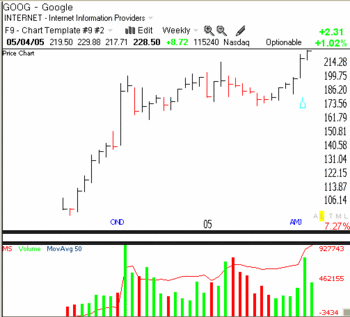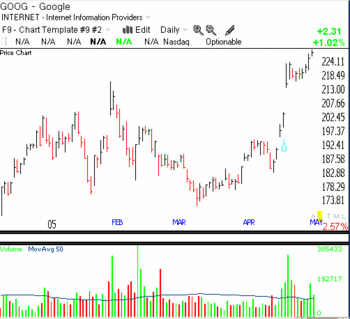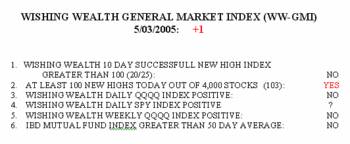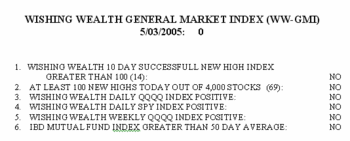I have a confession tonight. The past few days I have been saying that I do not fight a downtrend and stay mainly in cash or short. Well, I am not perfect. I could not resist nibbling at a stock that was resisting the downtrend. For several weeks now, Cramer has been recommending GOOG as a great buy. (I know I criticized Cramer yesterday for not urging viewers to go short or to cash, but he is not perfect either. We can forgive him.) Cramer maintains that GOOG will earn about $7 per share (total profit/total number of shares) this year. If the company has a PE ratio (price per share/earnings per share) like Yahoo’s (PE=55), then the stock could reach a price of around $385 (PE: 55=385/7). Now, I can’t just take Cramer’s word for it. I have to go to the charts to see if the stock is acting well.  You may remember that GOOG came public in a Dutch auction around August, 2004 at around $100. (Click on weekly chart to enlarge.) The media pundits all said that the stock was too expensive. That was a buy signal. The pros probably wanted to accumulate the stock without competing with the little guys. So the stock hesitated for a few days and then climbed to $216 by February, 2005. The stock doubled in less than one year!
You may remember that GOOG came public in a Dutch auction around August, 2004 at around $100. (Click on weekly chart to enlarge.) The media pundits all said that the stock was too expensive. That was a buy signal. The pros probably wanted to accumulate the stock without competing with the little guys. So the stock hesitated for a few days and then climbed to $216 by February, 2005. The stock doubled in less than one year!
Remember I wrote a few posts ago about my desire to find rockets as Darvas did–stocks that will go to the moon? Well, Darvas wrote that one thing he looked for in a stock was a doubling in the past year. The best predictor of a person’s behavior is his/her past behavior. The same is true for stocks. Want to find a stock that will double in the next year–find one that has already doubled in the past year. Don’t take my word for it. Look up some of the winners of the past bull market– DELL, CSCO and more recently, CME, BOOM, FORD and HANS. Rockets keep doubling and hitting new highs and always appear too expensive. You do want to go to the moon, don’t you? So GOOG passed that test. It was also trading near an all time high, another characteristic of a rocket.
GOOG declined for a few months and gapped up to a new high in late April (see daily chart) on huge volume, when great earnings were released. Clearly, people with a lot of money were purchasing this $200 stock. Was it too late for me to buy? Was the rise just caused by bears covering their short sales? (buying back the shares they had borrowed from their brokers and sold in anticipation that they could buy back them back at a cheaper price, and pocket the difference in price) Well, this is what I am trying to share with you tonight– I have found that many stocks begin their advance or decline with a huge gap in price. The trick is to wait to see if the gap is filled. If the stock keeps on rising to new heights without closing the gap, it is often a sign of tremendous strength. (Note that in January, 2005, a similar gap up was quickly filled—and failed.) I use TC2005 to scan the entire market for stocks that have gapped up or down.
Clearly, people with a lot of money were purchasing this $200 stock. Was it too late for me to buy? Was the rise just caused by bears covering their short sales? (buying back the shares they had borrowed from their brokers and sold in anticipation that they could buy back them back at a cheaper price, and pocket the difference in price) Well, this is what I am trying to share with you tonight– I have found that many stocks begin their advance or decline with a huge gap in price. The trick is to wait to see if the gap is filled. If the stock keeps on rising to new heights without closing the gap, it is often a sign of tremendous strength. (Note that in January, 2005, a similar gap up was quickly filled—and failed.) I use TC2005 to scan the entire market for stocks that have gapped up or down.
So, I bought a few shares of GOOG a few days after the gap, at around 220, and immediately placed a stop order to sell them around $214, if the stock started to close the gap. In other words, I was willing to take the risk of losing about $7 per share in exchange for the possibility of a profit of $50 or more per share. I have no idea if GOOG will continue to rise or not. My point is that I have placed my wager and can now separate myself emotionally from the stock. I will either profit or lose a little. (If you are unwilling to have a lot of small losses you should not trade stocks.) I don’t even watch GOOG very much. Remember, Darvas made his fortune when he was out of the country and far away from the market. The further one is away from the market, the less the emotion that can kill one’s judgment, and the trade. GOOG closed today at $228.50.
What I want you to understand from this example is the strategy to purchase a potential rocket, and then to place an immediate stop order to control your potential loss if you are wrong. (Note: A stop order to sell at $214 becomes a market order to sell as soon as the stock trades at or below the stop price. This does not guarantee the price I will get when I sell the stock. If GOOG gapped down from above $214 and opened at $210 one day, I would be sold out at the next price, probably around $210. This would be a relatively rare event, but there is always this risk when using sell stops.) The next decision I have is when to increase my position if the stock continues to rise and where to raise my sell stop to. Livermore and Darvas would make a small pilot buy and then add to the position only if the stock rose, proving them correct in their first purchase. NEVER BUY MORE OF A STOCK THAT HAS DECLINED–NEVER THROW GOOD $$$ AFTER BAD. Just take your loss, admit you were wrong and learn from your mistake.
——————————————————–
The WW-GMI moved to +1 today!  There were 103 new 52 week highs in the universe of 4,000 stocks that I follow. However, the IBD Mutual Fund Index remains below its declining 50 day moving average. The WW-Daily SPY index will turn positive tomorrow if SPY closes above 117 tomorrow. If this rally proves to have legs, I will begin to close out my put options and go long. The private education stocks were weak again today– APOL (-3.56%) and COCO (-.80%). I am ready to turn on a dime if this market shows me a definite change in trend. If it is a real change in trend, I will have plenty of time to gradually take on my line of stocks. Have a great trading day.
There were 103 new 52 week highs in the universe of 4,000 stocks that I follow. However, the IBD Mutual Fund Index remains below its declining 50 day moving average. The WW-Daily SPY index will turn positive tomorrow if SPY closes above 117 tomorrow. If this rally proves to have legs, I will begin to close out my put options and go long. The private education stocks were weak again today– APOL (-3.56%) and COCO (-.80%). I am ready to turn on a dime if this market shows me a definite change in trend. If it is a real change in trend, I will have plenty of time to gradually take on my line of stocks. Have a great trading day.
Let’s hope that Charles Kirk’s relative will get better soon and that he will return to writing his excellent blog soon, at www.thekirkreport.com.

